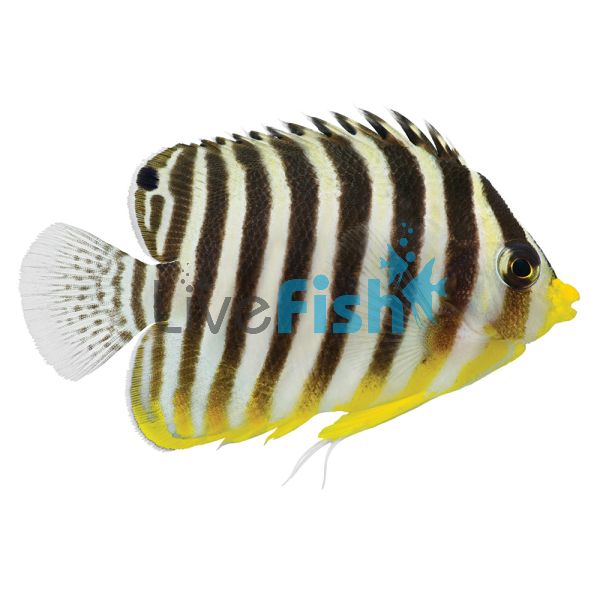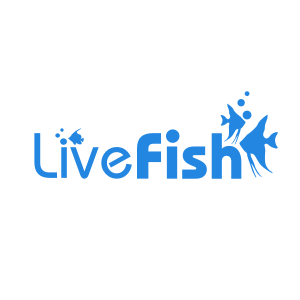Multi Barred Angelfish - Medium
These distinctive Dwarf Angelfish are easily recognisable with their vertical stripes. They are sociable and can be kept in pairs or larger groups in suitably sized aquariums.
Multi Barred Angelfish
The Multi Barred Angelfish is a deeper-bodied Angelfish species. They have eight individual black and yellow vertical bands. These start at its mouth and going through to its anal fin, with a thin stripe of white bordering each black band. Their tails are white to yellow with small black speckles. You can distinguish the juveniles by a blue eyespot at the back of the dorsal fin.
In the wild, the Multibar Angelfish live in harems with one dominant male and usually many females. Like other Dwarf Angelfish, they are hermaphroditic. They all start as females and the dominant ones will then develop into males. In a harem, if the male disappears then the most dominant female will then change into a male to take that role.
There are no distinguishable features in color variations from male to female. They are difficult to breed in captivity as they are broadcast spawners, releasing their gametes into the water column. The parents don’t look after their young. Upon hatching, they spend around 50 days in the pelagic phase before they are recognizable as juveniles.
They live in the Indo-Pacific region, specifically in the area from the Cocos-Keeling Atoll to the Society Islands, ranging north to the Yaeyama Islands and south to the Great Barrier Reef. It is usually found living at a depths between 20m and 70m inhabiting caves and crevices in outer reef slopes.
Tank Recommendations for Multi Barred Angelfish
The smallest tank these fish need is 70 gallons (265 liters). These fish are known to be fussy eaters in captivity. So it’s important to have a well-established aquarium with plenty of live rock and stones with algae growth for grazing. This can also be useful to provide plenty of cracks and crevices for hiding places for them.
They will nip at soft and stony polyp corals, sessile invertebrates, and clam mantles. So they aren’t generally considered to be reef safe. It is still possible to build up a mixed coral aquarium with these Angelfish. Corals that have a good chance of being left alone by this Angelfish are Hammer corals, Bubble corals, Star polyps, Disc anemones, and most of the SPS corals.
In the wild, these fish are used to lower light conditions often remaining deeper and spending time in caves. So to help acclimatize it, dim the light at first and gradually increase it to normal levels.
Suitable Tank Buddies
You should keep these fish in pairs or larger groups in a large enough aquarium. Keeping more than one specimen also helps when it comes to training them to accept pre-prepared foods.
Outgoing but not too aggressive tank mates work best. If you are keeping Multi Barred Angelfish with other species of Angelfish, ensure they aren't too aggressive.
Usually Compatible
Keeping them in a species-only tank is when these Angelfish usually do best. So keeping a pair or a male with a harem of females will work well. Other not overly aggressive fish, such as Tangs or Butterflyfish also co-habit well.
Sometime Compatible
Clownfish, less aggressive Damselfish and Wrasses can be kept with these Angelfish. You will still need to monitor them in case there become overly aggressive towards each other.
Rarely Compatible
Seahorses and Pipefish shouldn’t be hosed with these Angelfish as they will be outcompeted for food. Sharks, Eels, Snappers, Groupers and Rays will all see your Multi Barred Angelfish as a potential meal and so they won’t make good tank mates at all.
Feeding Your Multi Barred Angelfish
These fish are omnivores and in the wild feed on algae, sponges, tunicates and other benthic invertebrates and small crustaceans and can often be seen foraging upside-down on cave ceilings.
These fish can be difficult to accept food when introduced to the aquarium. In the aquarium, they prefer a variety of small meaty frozen foods such as chopped mussels, oysters, mysis and brine shrimps. They will usually accept live mysis and brine shrimps more readily at first. To get them to accept more foods you can mix in frozen foods, angelfish and herbivore preparations with live foods. Then as they start accepting these you can increase the amount of these and reduce the live food. You should also include some spirulina, marine algae and seaweed into their diet to keep them healthy. Their eating habits can make this a challenging fish to keep. This is why it is important to ensure that your tank is mature with plenty of algae growth for them to eat whilst you get them use to accepting other foods.
Once you get them to accept food regularly then we recommend feeding them 3 times a day.
| Scientific Name | Centropyge multifasciatus |
|---|




